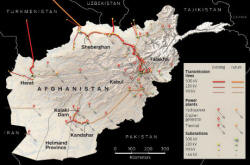Afghanistan's Buried Riches - Rare Earths & More |
||||||||||||||||||||||||||||||||||||||||||||||||||||||||||||||||||||||||||||||||||||||||||||||||||||||||||||||||||||||||||||||||||||||||||||||||||
|
1 | 2 | 3 | 4 | 5 | 6 | 7 | 8 | 9 | 10 | 11 | 12 | 13 | 14 | 15 | 16 | 17 | 18 | 19 | 20 | 21 | 22 | 23 | 24 | 25 | 26 | 27 | 28 | 29 | 30 | 31 | 32 | 33 | 34 | 35 | 36 | 37
If you are one of those people who said the whole reason for attacking Iraq was for oil profits, you will probably say the same about our presence in Afghanistan, only this time for real gold rather than black gold. If you are, then the fact that we have not received one drop of free oil from Iraq will probably not affect your belief about our likelihood of profiting off of Afghanistan. The fact is that just as the American taxpayer has funded untold billions of dollars worth of state-of-the-art power generation and transmission systems, schools, hospitals, daycare centers, roads, colleges, computers, medicine, cars and trucks, cellphones and towers, radios and televisions, toys and games, clothing, guns and ammunition, military gear, training for police, firefighters, teachers, medical personnel, and the list goes on, we have been doing the same thing in Afghanistan. Oh incidentally, we have paid for the same things in Kuwait, African countries, and elsewhere. Come to think of it, America did a lot of that for Europe after World War II4. But I digress. Are you surprised to learn that some of our soldiers have died to protect surveying efforts in Afghanistan? Well, here comes the real rub. Many multinational investors have begun staking claims all over the country for mining rights once the region is deemed safe enough to commence operations. One of the largest players is China Metallurgical Group with pending leases on a copper deposit with an estimate in value of at least $43B. Hmmm... funny that I could not find any references to China helping to fund the military operations in Afghanistan. In fact, when I do a search about China's involvement there, all I could find was information about how they have been abetting the resistance forces. Didn't China assist the forces in both North Vietnam and in North Korea? Yeah, I thought so. But hey, enjoy your cheap electronics and tools, and clothes, and toys, and furniture, and well, just about everything else. Didn't America assist China in its defense against the southern Japan invasion during World War II5? Yeah, I thought so. Dang, I digressed again. IEEE's October 2011 edition of Spectrum magazine also happened to run an article titled, "Re-Engineering Afghanistan: At What Cost?," reporting on our electrical power infrastructure work in Afghanistan. Trillion-dollar "Stimulus" packages are authorized here at home ostensibly to fund our own infrastructure projects - roads, bridges, dams, etc. - but the money has disappeared into a black hole and nobody seems to know where it went (of course it went to fund certain states' bloated employee pensions and immorally mismanaged budgets); meanwhile we also spend billions of our tax dollars in yet another country whose vast majority of the population wants to cut our throats - literally. Yes, our troops have died defending the power grid, too. Is anybody else tired of this? Our money and technical know-how builds the world while here at home we suffer record high unemployment and industry is dying at an ever-increasingly fast pace. Politicians are responsible for creating the laws and whacko regulations that have doomed America, yet the same ones are voted back into office cycle after cycle. A conspiracist might conclude it has all been intentional, because the only other explanation is gross incompetence on the part of government. If our Afghanistan experience turns out like Iraq has turned out, then don't count on getting any kind of return on your hard-earned tax money from the "investment" we have put into the place. Access to the full Scientific American article is restricted to digital subscribers (I subscribe to the tree-killing version), so the accompanying charts and tables that break down various countries' share of the rear earth metals, quantities imported versus quantities produced domestically, etc., are not readily available to most people. Below is a small sampling of the data presented. Ironically, this headline was just posted today: China Rare Earths Supplier Suspends Production 1: Rare Earth Mining in the United States Gets a Second Chance2: The SciAm website does not have the large map shown in the thumbnail, but it is on Nature's website. 6: Slideshow of U.S. troops protecting USGS scientists
See also Toxic Air from China, The Real Price of Gold, Afghanistan's Buried Riches - Rare Earths & More, E-Waste... Just Don't Think About It
Posted May 4, 2020 |
||||||||||||||||||||||||||||||||||||||||||||||||||||||||||||||||||||||||||||||||||||||||||||||||||||||||||||||||||||||||||||||||||||||||||||||||||
 "
"